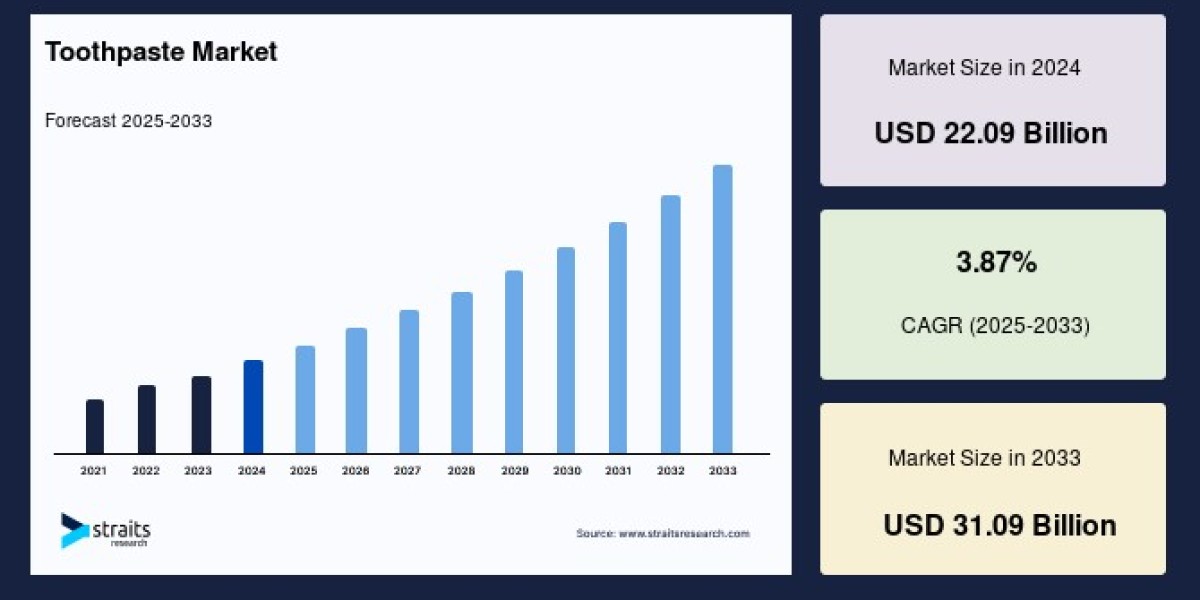Introduction
The global toothpaste market size had a revenue holding of USD 22.09 billion in 2024 and is projected to reach from USD 22.94 billion in 2025 to USD 31.09 billion by 2033, growing at a CAGR of 3.87% during the forecast period (2025-2033).
Market Overview and Product Composition
Toothpaste is a gel or paste product used along with a toothbrush to maintain oral hygiene by cleaning teeth and preventing dental disorders. Its core composition includes fluoride, sodium lauryl sulfate, glycerol, sorbitol, calcium carbonate, sweeteners, and flavoring agents, carefully formulated to protect teeth, reduce plaque, and freshen breath. The market is composed of multiple toothpaste categories, including conventional, whitening, sensitive, anti-cavity, tartar control, anti-gingivitis, and natural or herbal variants. These offerings cater to differing oral health needs such as cavity prevention, enamel strengthening, gum care, and cosmetic whitening.
Drivers of Market Growth
Several factors are fueling the toothpaste market expansion globally. The increasing prevalence of dental problems, especially among children, such as cavities and tooth decay, heightens the demand for effective formulations. Growing consumer education on oral health benefits and the risks associated with poor hygiene also plays a critical roles. For example, dental issues affect hundreds of millions of children worldwide, encouraging greater adoption of oral care routines involving toothpaste.
The rising preference for natural and herbal toothpaste products marks a significant trend in the market. Consumers are becoming wary of harsh chemicals like triclosan, artificial sweeteners, and parabens traditionally used in conventional toothpastes. This shift encourages manufacturers to innovate with plant-based ingredients and chemical-free formulations to meet demand for safer, environmentally friendly options.
Regional Insights
Asia-Pacific is the largest and fastest-growing regional market for toothpaste, driven by its vast population, rising disposable incomes, and increased grooming consciousness. Countries like India and China significantly contribute to revenue growth as consumers gravitate toward local, herbal, and natural toothpaste options. This region’s growth rate is projected to outpace many others, with a CAGR close to 4.94% forecast until 2030.
Europe represents the fastest-growing mature market, with rising demand for teeth whitening and specialized toothpaste formulas for enamel and gum care. Environmentally conscious consumers there are pushing companies to focus on recyclable packaging and natural ingredients. North America maintains stable growth thanks to consumer focus on whitening and sensitive teeth products, with strong market presence in the United States.
Market Segmentation by Consumer Groups and Distribution Channels
The adult demographic, comprising individuals older than 15 years, dominates toothpaste consumption due to their broad usage of varied toothpaste types both conventional and natural. This segment enjoys a CAGR nearing 4.72%. The children’s segment is the second largest, driven by needs for gentle, chemical-free formulations to combat cavities and sensitivity common in younger users.
Distribution channel dynamics strongly influence market growth. Supermarkets and hypermarkets command the largest share, benefiting from extensive product ranges and consumer convenience. Meanwhile, independent retail stores retain importance in rural areas where supermarket penetration is limited. Notably, online platforms are growing in prominence, offering accessibility to diverse toothpaste options with home delivery benefits.
Industry Innovations and Challenges
Advancements in toothpaste formulations now target multi-benefit products addressing whitening, plaque, sensitivity, and tartar control simultaneously, enhancing consumer convenience. Packaging innovations focus on ecological sustainability, with firms investing in recyclable tubes to reduce environmental impact from traditional plastic and aluminum containers.
However, challenges persist, such as managing differences in consumer preferences globally and navigating regulatory requirements across countries. The rising costs of dental care and the need to educate less aware populations remain barriers in some emerging markets.
Conclusion
The toothpaste market is set for consistent, moderate growth through 2033, driven by heightened oral health awareness, population growth, and consumer demand for diversified and environmentally responsible products. The continued innovation in natural toothpaste offerings and packaging sustainability will likely create new opportunities for manufacturers. Regional trends, particularly the expansion in Asia-Pacific and the premiumization in Europe and North America, highlight the varied but complementary drivers shaping this essential personal care segment in the coming years.













